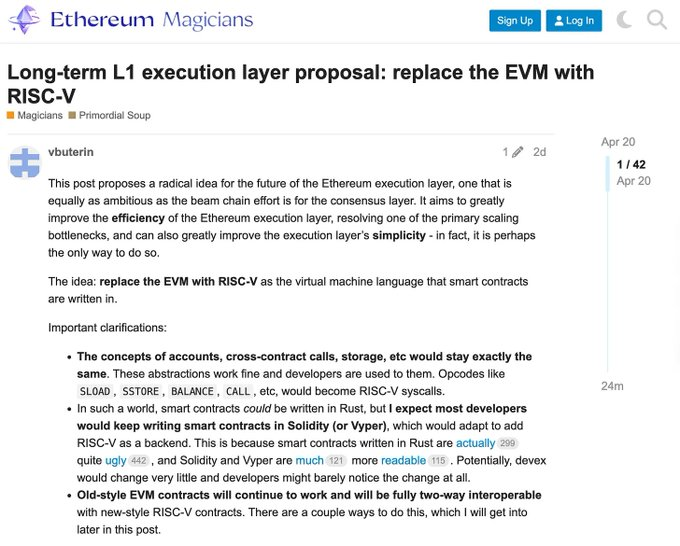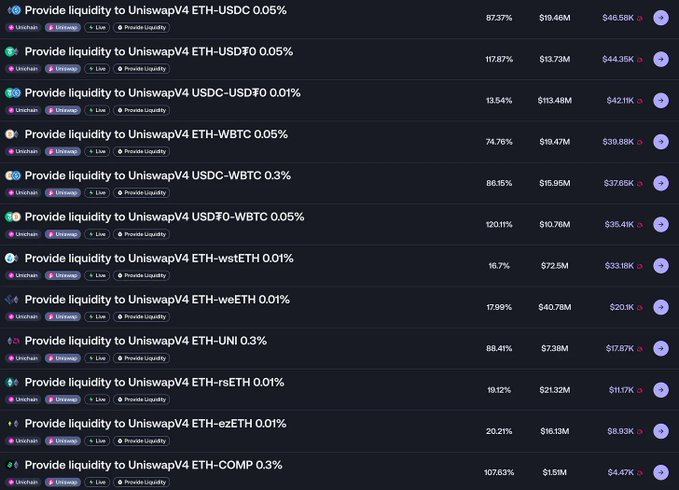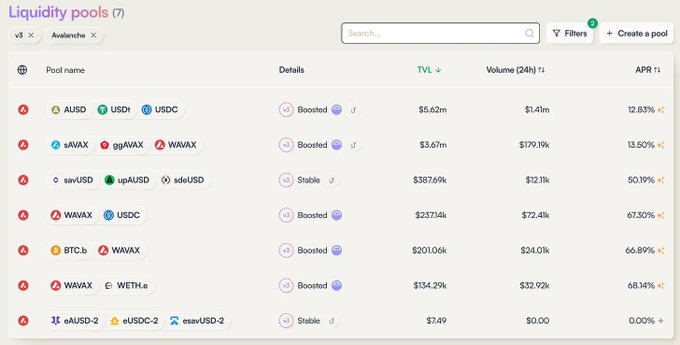Author: Chen Mo cmDeFi
Ethereum engine reconstruction discussion;
Ethena chooses Arbitrum camp;
Unichain, MakerDAO, old DeFi are all moving;
Thoughts on DeFi in the recent week.
1/ First, about ETH, Vitalik proposed using RISC-V to replace EVM as the long-term execution layer.
A simple explanation:
(1) Can be roughly understood as changing the engine, with the goal of improving efficiency
(2) Addressing potential massive computational consumption in the future
(3) Breaking through the performance ceiling difficult to overcome under the EVM framework
(4) This change only occurs in the underlying execution engine
(5) Will not change Ethereum's account model or contract call methods
(6) Users and developers do not need to change their interaction method with smart contracts when using Ethereum
In summary, Vitalik believes that in the long term, the bottleneck of Ethereum's execution layer will ultimately face issues that are difficult to verify or require special hardware to run (massive computational resource consumption), which would limit scalability. Using RISC-V is a solution to this problem. As for why RISC-V is better, it represents a universal and efficient computing model, with a more mature hardware and software ecosystem. It is currently still in the discussion stage, and implementing this change would not be small, with an estimated timeline of several years from now.

2/ Ethena's Chain Launch
Converge choosing the Arbitrum camp was personally surprising, as the OP Superchain has Unichain, Base, and other strong players, with Arbitrum at a clear disadvantage. While Arbitrum Orbit and OP Superchain are both L2 expansion solutions, they differ in design:
(1) Orbit allows developers to create dedicated Rollup or AnyTrust chains: can directly anchor to Ethereum as L2 or anchor to Arbitrum as L3.
(2) OP Superchain's vision is a network composed of multiple parallel L2s. These L2s (called OP Chains) are built on a shared OP Stack standard code library.
Informally speaking: Orbit is vertical scaling, Superchain is horizontal scaling. They have different views on modularity and flexibility. Orbit advocates openness, such as Orbit chain's DA can choose to directly publish data on Ethereum (Rollup method), maintained by a Data Availability Committee (DAC), or integrate with external data availability networks like Celestia. Superchain focuses on providing an EVM execution environment equivalent to Ethereum, emphasizing consistency with Ethereum and multi-chain standardization, with modular changes requiring caution.
3/ Unichain Liquidity Mining Situation
Returns are still considerable, but require interval control. Full-interval mining lacks presence (Merkl's APR is inaccurate, requiring calculation based on funds and interval). Compared to the previous liquidity mining version, the threshold and difficulty have increased. New users are not enthusiastic, meme players won't participate. The current audience is mainly old miners. For old miners, the lack of new users competing for returns is actually quite good. They complain verbally but are still actively participating. Using this to make DeFi go mainstream seems difficult.

4/ Ripple's Stablecoin RLUSD Has Entered Mainstream DeFi Protocols
(1) Aave has added RLUSD to V3
(2) Curve Pool has deployed 53M in liquidity
Stablecoins are truly hot this year. Each cycle seems to have a place for this track. They always find an angle. When not compliant, algorithmic stablecoins perform; when the compliance environment is good, the big players also join in.
5/ Optimism Launches SuperStacks Activity, Preparing for Upcoming Superchain Interoperability Features
(1) From April 16, 2025, to June 30
(2) Encouraging users to participate in DeFi on Superchain and earn XP
(3) Protocols can also stack their own incentives
(4) OP officially says no airdrop, just a social experiment
If you're following Superchain, you can participate. For example, mining on Unichain while earning XP. Not recommended to deliberately farm. Superchain's interoperability has been something I've been watching, waiting to see what changes will come after official launch.
6/ BalancerV3 Launches on Avalanche, Accompanied by $AVAX Incentives
Rewards are still okay, but capacity is average. BAL was previously delisted by Binance, but the protocol is still actively working, including ecosystem collaborations and iterations. This old DeFi hasn't become a leader like Uniswap or Aave, and lacks the token issuance dividend of new DeFi, making survival difficult. Can only hope for an on-chain explosion.

7/ Circle Launches CPN Network, Targeting Global Payment Market
A compliant, seamless, and programmable framework that aggregates financial institutions, aiming to coordinate global payments through fiat, USDC, and other payment stablecoins. The network is designed to overcome infrastructure barriers faced by stablecoins in mainstream payments, such as unclear compliance requirements, technical complexity, and issues with secure digital cash storage.
First addressing cross-border payment issues, replacing traditional slow and expensive payment environments. This track was previously known for Ripple, but not very familiar. Providing programmability is a good thing, promoting blockchain adoption. If each country has an on-chain stablecoin, the landscape would be different, essentially promoting more countries to issue compliant stablecoins.
8/ "Bridge" War
(1) GMX chooses LayerZero as the message transmission bridge for multi-chain expansion plan
(2) a16z crypto purchased LayerZero tokens worth $55M, locked for three years
(3) Wormhole releases future roadmap
Some thoughts:
This track is very necessary but also very crowded. Most earnings are from transaction fees, which will become increasingly competitive, good for users as fees will be driven down. From a protocol integration perspective, stability and security need to be considered.
These giants have super high valuations. From an economic model perspective, they are difficult to design. From this angle, such business is more suitable for creating a separate chain or integrating similar mechanisms into a PoS chain's token model.
9/ Spark(MakerDAO) Deploys $50M to Maple
Worth noting, this is Spark's first fund deployment outside the US Treasury domain, with a limit of $100 million.
Who is Maple?
Maple focuses on connecting on-chain and off-chain unsecured lending, with main products including Maple Finance platform and Syrup derivative platform:
(1) Maple's customers are qualified investors and institutions on both sides
(2) Syrup's customers expand on-chain user deposits through SyrupUSDC
A key role in Maple:
Pool Delegates: Usually reputable institutions or trading companies responsible for managing loan pools. They are core managers in the Maple ecosystem, with responsibilities including:
- Conducting credit assessments on borrowers, deciding whether to approve loans
- Setting loan terms (such as interest rates, duration, etc.)
- Monitoring loan execution and repayment
- Responsible for asset recovery if borrowers default
It's clear that the protocol's operation critically depends on Pool Delegates.
Maple is an old project that wasn't popular in the last cycle, mainly because its business model involves absorbing on-chain deposits and then unsecured lending to off-chain clients through centralized means. This concept was not easily accepted before. However, this cycle, due to changes in compliance environment and user thinking, it has gradually been accepted. But personally, USDS choosing to deploy funds to Maple still seems like a relatively high-risk move.







